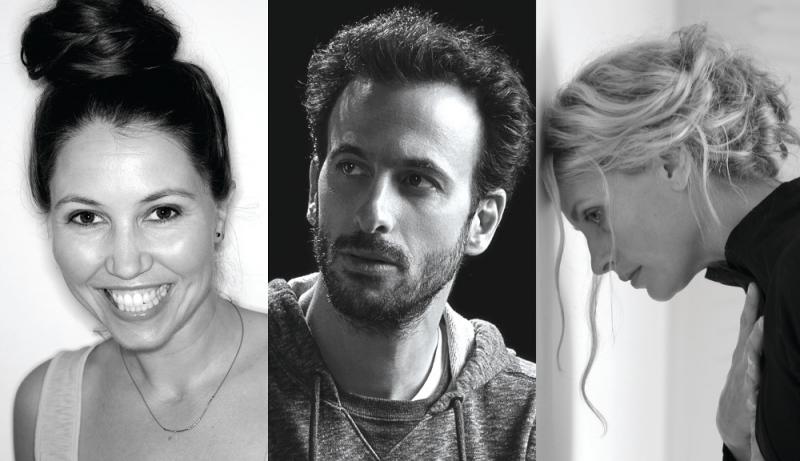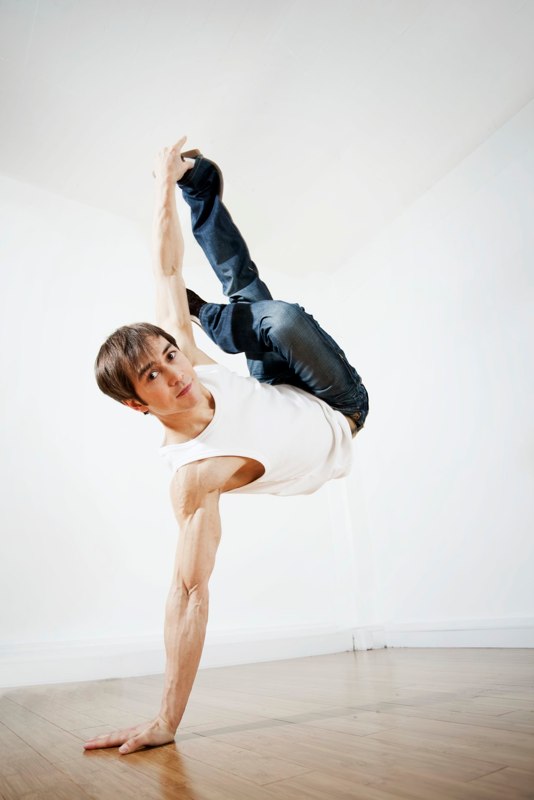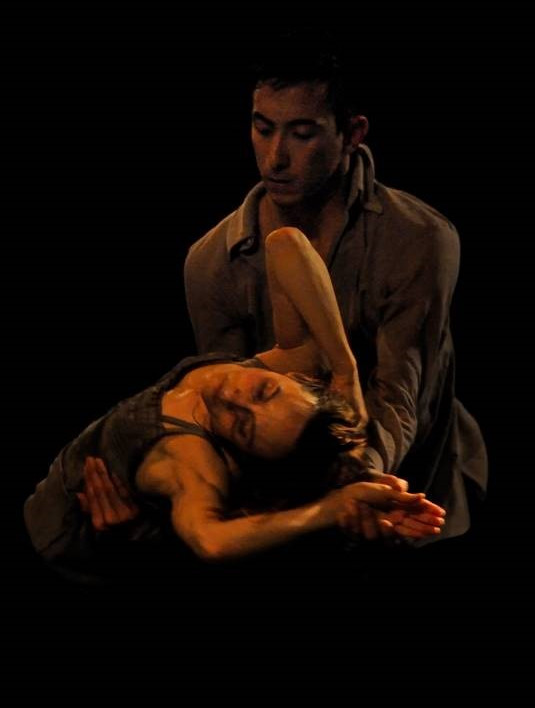The Associates, Sadler's Wells | reviews, news & interviews
The Associates, Sadler's Wells
The Associates, Sadler's Wells
Crystal Pite's reworked duet pips premières from Kate Prince and Hofesh Shechter

The Associates is not the title of a new Scandi crime drama, though in dance world terms we’re perhaps approaching that level of Event. Associates are what Sadler’s Wells, London’s dance powerhouse, calls the selected band of dancemakers it deems serioulsy interesting, and worth co-commissioning.
Prince’s piece, Smile - co-choreographed by Shaun Smith and Tommy Franzén - has a decent conceit, exploring the world of sadness under the comedian’s mask through the figure of Charlie Chaplin. It’s a terrific role for Franzén (pictured below right), who switches tirelessly and fluidly between Chaplin-esque vaudeville routines and more introspective, contemporary solos, and reveals a satisfying resonance between the movement vocabularies of slapstick and hip-hop. The same relationship was picked up in the soundtrack, which at first alternated between caper-movie bubbling and contemporary urban music, but then began to mix the two, sampling Louis Armstrong’s voice over an electronic beat, and playing Jay-Z’s Empire State of Mind with a big band. The problem was that neither dancer nor choreography adequately created – or differentiated – the twin atmospheres of hilarity and depression: the comedy routines weren’t all that funny, the sad solos not all that moving, and the endless pushing around of props just irritating. That could have been part of the plan – drawing attention to the simple labour, and occasional tedium, involved in entertainment - but I suspect from the programme note that the aim was a more straightforward "tears of a clown" pathos, and that Prince, Smith and Franzén didn’t quite supply. The mere mention in the programme of Robin Williams gave me more chills than the entire 30 or 40 minutes we spent with Franzén’s Chaplin character in Smile.
The problem was that neither dancer nor choreography adequately created – or differentiated – the twin atmospheres of hilarity and depression: the comedy routines weren’t all that funny, the sad solos not all that moving, and the endless pushing around of props just irritating. That could have been part of the plan – drawing attention to the simple labour, and occasional tedium, involved in entertainment - but I suspect from the programme note that the aim was a more straightforward "tears of a clown" pathos, and that Prince, Smith and Franzén didn’t quite supply. The mere mention in the programme of Robin Williams gave me more chills than the entire 30 or 40 minutes we spent with Franzén’s Chaplin character in Smile.
One of the amazing – surely coincidentlal – similarities between all three pieces on show was a sense of the characters being controlled from beyond the stage, frozen in sudden spotlights or told to move by the music or disembodied voices. This self-conscious theatricality was both noisiest and most sinister in Hofesh Shechter’s brand new piece, The Barbarians in Love, the first of a planned trilogy, apparently. The female voice in his soundtrack is turned up so loud that her sibilants turn into ear-grating electronic smudges, and she sounds like a capricious deity – or at least a robot overlord from Doctor Who – intoning “unity must be....” and other instructions to the six dancers, who caper around in a striking mixture of pseudo-ballet and pseudo-monkey, accompanied by fragments of Couperin’s viola da gamba music.
Just as you’re wondering what it’s all supposed to mean, Shechter goes meta: we hear a recorded conversation between him and the female voice, where she berates him for being obvious, and he stammers out his intentions in making the piece and worries out loud about the audience laughing at him, before shutting them up with a discomfiting revelation. Then the dancers get naked and stand still in low light for about five minutes accompanied by a monotonous bass hum. Was it supposed to be elemental? Transcendental? I don’t know. It certainly proves that Shechter doesn’t need the bone-shaking music of his earlier pieces in order to get under an audience’s skin, though perhaps irritation at an overlong, inscrutable piece wasn’t precisely the impact he had in mind.
Movements ripple along limbs in slow convulsionsCrystal Pite’s piece, A Picture of You Falling (2008) the middle one of the evening, used self-conscious theatricality to engage rather than alienate the audience. It’s a duet between dancers Peter Chu and Annie Plamondon (pictured below right), based on that commonest of duet tropes, a romantic relationship, but Pite takes it out of the ordinary in so many ways. A narrator with a velvety, governessy voice tells the story in the second person through vignettes like Polaroid shots: “this is a picture of you, falling. Knees, hips, hands, head.” The text, written by Pite herself, captures the peculiarly haunting effect of the second person voice, while the choreography brilliantly imitates the kind of storytelling, a mixture of realist detail and things left unsaid, used by the doyenne of second-person short stories, Lorrie Moore. We see the two dancers, first apart then together, but we don’t hear or see all the facts of the relationship. Movements and modulations are hidden by the darkness between ‘scenes’, and though there is a semicircle of lanterns outlining the dancing area, their potential for forensic illumination is never used: the dancers move in and out of shadow, even slipping behind the lights to reappear in a different place as if teleported. Pite uses a rich blend of movement vocabularies – after Prince’s piece, I noticed slowed-down hip hop in there – given coherence by an extreme silkiness of execution. There’s always a sense of the underwater about her pieces: her dancers are soundless and uncanny as fish or better, tentacled creatures like octopi, for she makes a feature of movements which ripple along limbs in slow convulsions, sometimes elegant, but sometimes odd (shoulders pulled back at awkward angles, extreme back extensions). In A Picture of You Falling, the combination of this movement style, beautifully realised by Cho and Plamondon, with the simple but mysterious story is both haunting and compelling.
We see the two dancers, first apart then together, but we don’t hear or see all the facts of the relationship. Movements and modulations are hidden by the darkness between ‘scenes’, and though there is a semicircle of lanterns outlining the dancing area, their potential for forensic illumination is never used: the dancers move in and out of shadow, even slipping behind the lights to reappear in a different place as if teleported. Pite uses a rich blend of movement vocabularies – after Prince’s piece, I noticed slowed-down hip hop in there – given coherence by an extreme silkiness of execution. There’s always a sense of the underwater about her pieces: her dancers are soundless and uncanny as fish or better, tentacled creatures like octopi, for she makes a feature of movements which ripple along limbs in slow convulsions, sometimes elegant, but sometimes odd (shoulders pulled back at awkward angles, extreme back extensions). In A Picture of You Falling, the combination of this movement style, beautifully realised by Cho and Plamondon, with the simple but mysterious story is both haunting and compelling.
Four stars for A Picture of You Falling. It would have been three for each of the other two if they had been on their own, but the evening as a whole was evidence of an interesting vogue for creative approaches to narrative in contemporary dance, and for that I commend it.
- This programme is on at Sadler's Wells until Sunday 8 February.
rating
Explore topics
Share this article
Add comment
The future of Arts Journalism
You can stop theartsdesk.com closing!
We urgently need financing to survive. Our fundraising drive has thus far raised £49,000 but we need to reach £100,000 or we will be forced to close. Please contribute here: https://gofund.me/c3f6033d
And if you can forward this information to anyone who might assist, we’d be grateful.

Subscribe to theartsdesk.com
Thank you for continuing to read our work on theartsdesk.com. For unlimited access to every article in its entirety, including our archive of more than 15,000 pieces, we're asking for £5 per month or £40 per year. We feel it's a very good deal, and hope you do too.
To take a subscription now simply click here.
And if you're looking for that extra gift for a friend or family member, why not treat them to a theartsdesk.com gift subscription?
more Dance
 'We are bowled over!' Thank you for your messages of love and support
Much-appreciated words of commendation from readers and the cultural community
'We are bowled over!' Thank you for your messages of love and support
Much-appreciated words of commendation from readers and the cultural community
 How to be a Dancer in 72,000 Easy Lessons, Teaċ Daṁsa review - a riveting account of a life in dance
Michael Keegan-Dolan's unique hybrid of physical theatre and comic monologue
How to be a Dancer in 72,000 Easy Lessons, Teaċ Daṁsa review - a riveting account of a life in dance
Michael Keegan-Dolan's unique hybrid of physical theatre and comic monologue
 A Single Man, Linbury Theatre review - an anatomy of melancholy, with breaks in the clouds
Ed Watson and Jonathan Goddard are extraordinary in Jonathan Watkins' dance theatre adaptation of Isherwood's novel
A Single Man, Linbury Theatre review - an anatomy of melancholy, with breaks in the clouds
Ed Watson and Jonathan Goddard are extraordinary in Jonathan Watkins' dance theatre adaptation of Isherwood's novel
 Peaky Blinders: The Redemption of Thomas Shelby, Rambert, Sadler's Wells review - exciting dancing, if you can see it
Six TV series reduced to 100 minutes' dance time doesn't quite compute
Peaky Blinders: The Redemption of Thomas Shelby, Rambert, Sadler's Wells review - exciting dancing, if you can see it
Six TV series reduced to 100 minutes' dance time doesn't quite compute
 Giselle, National Ballet of Japan review - return of a classic, refreshed and impeccably danced
First visit by Miyako Yoshida's company leaves you wanting more
Giselle, National Ballet of Japan review - return of a classic, refreshed and impeccably danced
First visit by Miyako Yoshida's company leaves you wanting more
 Quadrophenia, Sadler's Wells review - missed opportunity to give new stage life to a Who classic
The brilliant cast need a tighter score and a stronger narrative
Quadrophenia, Sadler's Wells review - missed opportunity to give new stage life to a Who classic
The brilliant cast need a tighter score and a stronger narrative
 The Midnight Bell, Sadler's Wells review - a first reprise for one of Matthew Bourne's most compelling shows to date
The after-hours lives of the sad and lonely are drawn with compassion, originality and skill
The Midnight Bell, Sadler's Wells review - a first reprise for one of Matthew Bourne's most compelling shows to date
The after-hours lives of the sad and lonely are drawn with compassion, originality and skill
 Ballet to Broadway: Wheeldon Works, Royal Ballet review - the impressive range and reach of Christopher Wheeldon's craft
The title says it: as dancemaker, as creative magnet, the man clearly works his socks off
Ballet to Broadway: Wheeldon Works, Royal Ballet review - the impressive range and reach of Christopher Wheeldon's craft
The title says it: as dancemaker, as creative magnet, the man clearly works his socks off
 The Forsythe Programme, English National Ballet review - brains, beauty and bravura
Once again the veteran choreographer and maverick William Forsythe raises ENB's game
The Forsythe Programme, English National Ballet review - brains, beauty and bravura
Once again the veteran choreographer and maverick William Forsythe raises ENB's game
 Sad Book, Hackney Empire review - What we feel, what we show, and the many ways we deal with sadness
A book about navigating grief feeds into unusual and compelling dance theatre
Sad Book, Hackney Empire review - What we feel, what we show, and the many ways we deal with sadness
A book about navigating grief feeds into unusual and compelling dance theatre
 Balanchine: Three Signature Works, Royal Ballet review - exuberant, joyful, exhilarating
A triumphant triple bill
Balanchine: Three Signature Works, Royal Ballet review - exuberant, joyful, exhilarating
A triumphant triple bill
 Romeo and Juliet, Royal Ballet review - Shakespeare without the words, with music to die for
Kenneth MacMillan's first and best-loved masterpiece turns 60
Romeo and Juliet, Royal Ballet review - Shakespeare without the words, with music to die for
Kenneth MacMillan's first and best-loved masterpiece turns 60

Comments
As someone a little bit older